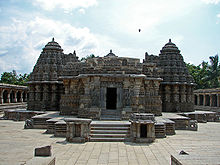|
Sacred Ensembles of the Hoysalas
The Sacred Ensembles of the Hoysalas is a group of three Hoysala-style temples in South India recognized as a World Heritage Site. These temples at Somanathapura, Belur and Halebidu, were built between the 12th and 13th centuries under the Hoysala Empire.[1] The three temples under the title of the Sacred Ensembles of the Hoysalas were inscribed on the UNESCO World Heritage List in 2023, for their outstanding architecture, hyper-realistic sculptures and stone carvings.[2] The architectural style of the three temples was developed by the early Hoysala rulers – who established their new kingdoms and regimes in South India – as a distinctive and innovative sacred architecture, which distinguishes the temples from contemporary kingdoms and dynasties.[3][4] These temples are as follows:
LocationLocation of Sacred Ensembles of the Hoysalas. The Sacred Ensembles of the Hoysalas is located in three places in two districts of Karnataka, there are two temples in Hassan district and one temple in Mysore district.[5] The Chennakeshava Temple is located in Belur, about 35 kilometers (22 mi) northwest of Hassan town, the headquarter of Hassan district. The temple is about 16 kilometers (9.9 mi) away from Halebidu Temple. The nearest airport to the temple is Bangalore Airport, from which it is a 220 km (137 mi) long drive of about 3.5 hours on National Highway 75 heading west.[6] The Hoysaleswara Temple is located in Halebidu town in Hassan district of Karnataka state. It is about 30 km (19 ma) north-west of Hassan and about 16 km (9.9 ma) from Belur temple. The temple is reached by a 210 km (130 mi) long drive of about 4 hours on the National Highway 75 heading west from Bangalore Airport.[6] The nearest city to both the temples of Hassan district is Hassan, which is connected to the major cities of Karnataka by railway network. The Keshav Temple is located at Somnathpura, 38 kilometers (24 mi) east of Mysore city, the headquarters of Mysore district.[7] HistoryThe Hoysala dynasty ruled large parts of present-day Karnataka between the 11th and 14th centuries. By the end of the 12th century, they had expanded the agrarian economic system of their kingdom and had also begun to establish taxation, revenue and administrative systems, thus beginning the process of state formation. At the same time, the Hoysala kings made a concerted effort to establish a new and distinct identity for their kingdom through patronage of art, architecture and literature. As a result, a new form of temple architecture developed, combining superior carving and superior decoration with innovative temple planning. This architectural style synthesized and combined architectural features prevalent in different parts of the country with original elements in innovative ways.[5] One of the Hoysala kings was Vishnuvardhana, who came to power in 1110 AD. He commissioned the Chennakeshava Temple dedicated to Vishnu in 1117 AD, it considered the "five foundations" of his legacy.[8][9] The main Chennakeshava Temple at Belur was completed in 1117 AD, although the complex continued to expand for over 100 years. Ketamalla, an employee of King Vishnuvardhana, built the Hoysaleswara Temple in 1150 AD. It also mentions that the king granted land for the construction, operation and maintenance of the Shiva temple in 1121 AD. It is the largest temple built by the Hoysala kings dedicated to the Hindu god Shiva. The Keshav Temple at Somanathapura was completed in 1258 AD by King Somnath. He also built a fort wall around the land, but these are now in ruins. The Hoysala kings employed many famous architects and craftsmen, who developed a new architectural tradition, which art historian Adam Hardy calls the Karnata Dravida tradition. The temples became targets of plundered and destruction by the Delhi Sultanate army of Alauddin Khalji in the early 14th century[10] and another Delhi Sultanate army of Sultan Muhammad bin Tughluq in 1326 AD.[11] According to a 15th-century inscription, the Keshav Temple was also badly damaged. It was repaired in the 16th century with financial support and grants from the emperors of the Vijayanagara Empire. Repairs are evidenced by the varying color and quality of stonework in the veranda and north tower and in parts of the platform of the main temple. The repaired temples was damaged in the 19th century, then rebuilt by the colonial-era Government of Mysore in the early 20th century.[12] Temples
References
External links
|
||||||||||||||||||||||||||||||||||||||




